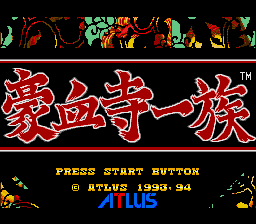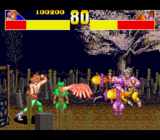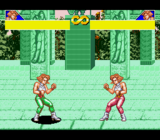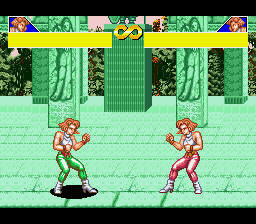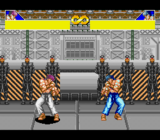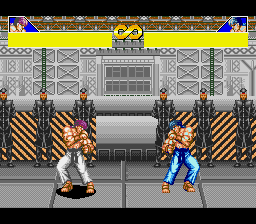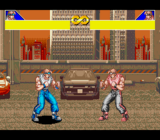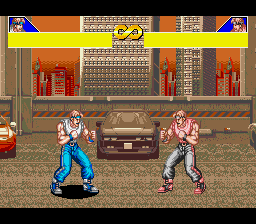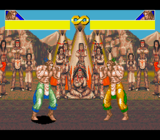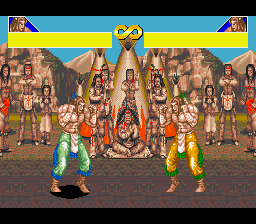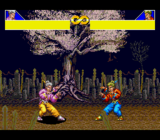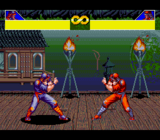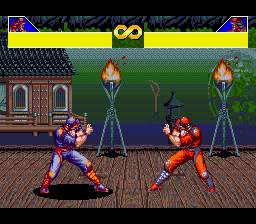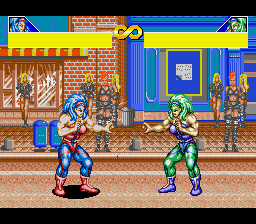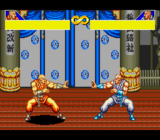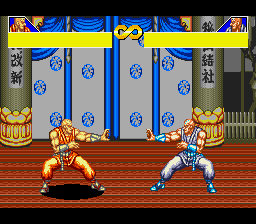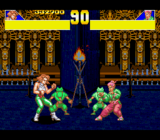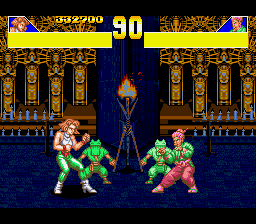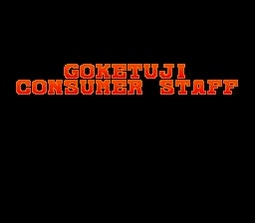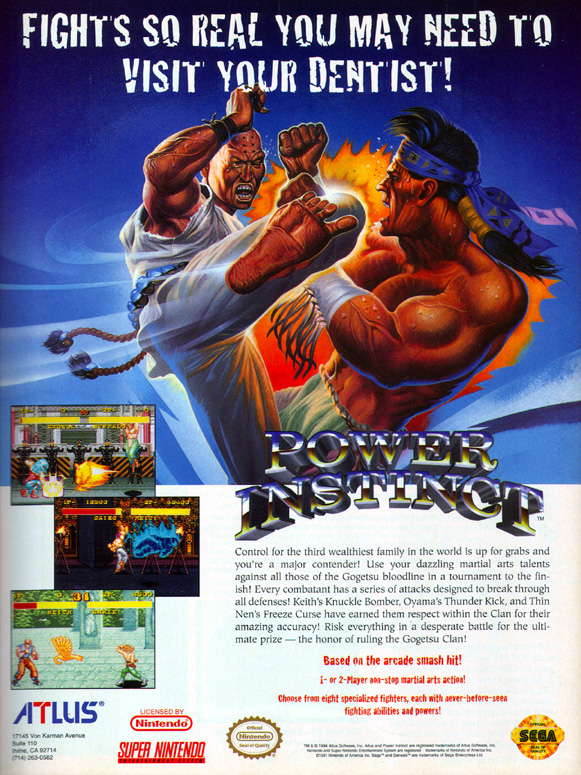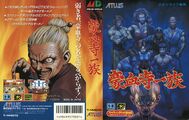Gouketsuji Ichizoku
From Sega Retro
| Gouketsuji Ichizoku | ||||||||||
|---|---|---|---|---|---|---|---|---|---|---|
| System(s): Sega Mega Drive | ||||||||||
| Publisher: Atlus | ||||||||||
| Developer: Atlus | ||||||||||
| Original system(s): Arcade boards | ||||||||||
| Sound driver: SMPS Z80 (modified) | ||||||||||
| Peripherals supported: Six Button Control Pad | ||||||||||
| Genre: Action[1][2] | ||||||||||
| Number of players: 1-2 | ||||||||||
| ||||||||||
|
Gouketsuji Ichizoku (豪血寺一族) is a 1993 arcade fighting game by Atlus and the first in the long-running series of the same name. Atlus ported it to the Sega Mega Drive in 1994, releasing it exclusively in Japan.
Plans were made to port the game to the US under the name Power Instinct (for release in October 1994[4] and later January[5]), then February 1995[6], but were scrapped. A US port was released for the Super NES.
Contents
Story
The wealthy and powerful Gouketsuji clan is holding a tournament to determine who will replace 78-year-old Oume Gouketsuji as head of the clan. Any person with blood ties to the clan can enter.
Gameplay
The game is a versus fighting game similar to Street Fighter II. Matches are fought to the best of three rounds, and a round is won when one fighter depletes the other's health to zero. Rounds are timed, and if time runs out, the round goes to whichever fighter has the most health remaining.
Characters move with ![]() and
and ![]() and dash with
and dash with ![]()
![]() or
or ![]()
![]() . Characters are invulnerable while back dashing. Forward dashes can be canceled by pressing
. Characters are invulnerable while back dashing. Forward dashes can be canceled by pressing ![]() . Characters crouch with
. Characters crouch with ![]() and jump with
and jump with ![]() . Every character can double jump by pressing
. Every character can double jump by pressing ![]() again in midair and triangle jump by pressing the D-Pad in the opposite direction when jumping onto the side of the screen.
again in midair and triangle jump by pressing the D-Pad in the opposite direction when jumping onto the side of the screen.
When using a standard control pad, characters can perform a light punch with ![]() , a light kick with
, a light kick with ![]() , a strong punch with
, a strong punch with ![]() , and a strong kick with START . When using a Six Button Control Pad, characters can perform a light punch with
, and a strong kick with START . When using a Six Button Control Pad, characters can perform a light punch with ![]() , a strong punch with
, a strong punch with ![]() or
or ![]() , a light kick with
, a light kick with ![]() , and a strong kick with
, and a strong kick with ![]() or
or ![]() . The attack performed varies depending on whether the character is standing, jumping, or crouching and the distance from the opponent. Characters can also attack while dashing toward an opponent; dashing kicks can knock opponents back. Every character has four special moves that are done by performing a motion on the D-Pad before punching or kicking.
. The attack performed varies depending on whether the character is standing, jumping, or crouching and the distance from the opponent. Characters can also attack while dashing toward an opponent; dashing kicks can knock opponents back. Every character has four special moves that are done by performing a motion on the D-Pad before punching or kicking.
Blocking is done by holding the D-Pad away from the opponent, which can also be done while crouching. Special moves still inflict a small amount of "chip damage" when blocked. Characters that are hit in midair by an attack that does not knock them down can recover by jumping (if they have not already used their double jump). Throws and grabs are done by holding ![]() or
or ![]() when next to an opponent and pressing a hard punch button. Throws cannot be blocked and can be done in midair. Characters are stunned when they are attacked repeatedly, becoming uncontrollable for a short duration.
when next to an opponent and pressing a hard punch button. Throws cannot be blocked and can be done in midair. Characters are stunned when they are attacked repeatedly, becoming uncontrollable for a short duration.
Modes
There are several modes:
- Story: The single-player mode. The player chooses any character and fights a match against every character in the game, ending with a fight against Gouketsuji clan leader Oume. A second player can challenge the first at any point by pressing START on a second control pad, with the winner of the match continuing in the tournament.
- Vs Mode: A two-player versus mode. Players choose any character, a handicap, and any stage. The game keeps track of wins, loses, and ties.
- Battle Royal: A two-player battle mode where players choose between 1 and 8 characters (which can be the same character) and fight a single match with all of them. When one player's fighter is defeated, the player's next fighter enters the battle, until all of one player's fighters have been eliminated. The match consists of a single round with no time limit.
- Practice: A training mode that can be played against a dummy character (standing or crouching), an active computer, or another human player. There is no time limit, and characters cannot be defeated, even when they lose all of their health.
- Karaoke: A karaoke mode that plays one of two songs ("Tatanka no Uta" or "Otoko no Karatemichi"), with lyrics displayed on the screen.
There are eight difficulty levels for computer-controlled opponents. Character endings are only shown in the Story mode when the difficulty level is set to 6 or higher (the default is 4). The player can also choose the time limit for each round (30, 60, or 90 seconds or no limit).
There is a "Power Config" options menu that lets players change the damage dealt by any character's normal moves and by each of their special moves. These settings do not affect the Story mode.
Characters
Note: Move lists assume that the character is facing right. When facing left, ![]() and
and ![]() should be reversed.
should be reversed.
| P | Any punch button |
| LP | Light punch |
| HP | Hard punch |
| K | Any kick button |
| LK | Light kick |
| HK | Hard kick |
Players can assign special moves to a single button in the options before starting a game (which works in every game mode except the Story mode). This only performs the LP and LK versions of special moves.
Playable
Bosses
| Oume Gouketsuji (豪血寺・お梅) | |
|---|---|
|
Country: Age: 79 Blood type: Unknown | |
| The fourth and current head of the Gouketsuji clan and the older twin sister of Otane. To master her mysterious attacks, she confined herself to the mountains. She has an eerie and unearthly presence about her, and it is rumored that she can turn her opponents to stone just by gazing into their eyes.
Oume is a palette swap of Otane and has a similar moveset (including the ability to temporarily transform into a younger and stronger version of herself). She is not playable. |
Stages
Each character has his or her own stage where matches are hosted. Stages are wider than they appear and contain barriers that can be broken by knocking characters into them, extending the playable area.
Production credits
Magazine articles
- Main article: Gouketsuji Ichizoku/Magazine articles.
Promotional material
Artwork
Physical scans
| Sega Retro Average | ||||||||||||||||||||||||||||||||||
|---|---|---|---|---|---|---|---|---|---|---|---|---|---|---|---|---|---|---|---|---|---|---|---|---|---|---|---|---|---|---|---|---|---|---|
|
| 61 | |
|---|---|
| Based on 6 reviews | |
Technical information
- Main article: Gouketsuji Ichizoku/Technical information.
References
- ↑ File:GI MD JP Box.jpg
- ↑ 2.0 2.1 https://sega.jp/history/hard/megadrive/software_l.html (Wayback Machine: 2020-07-02 23:21)
- ↑ Beep! MegaDrive, "November 1994" (JP; 1994-10-08), page 10
- ↑ Game Players, "Vol. 7 No. 10 October 1994" (US; 1994-xx-xx), page 11
- ↑ Electronic Gaming Monthly, "December 1994" (US; 1994-xx-xx), page 310
- ↑ VideoGames, "February 1995" (US; 1995-0x-xx), page 54
- ↑ File:Gouketsuji Ichizoku MD credits.pdf
- ↑ 1700 igr dlya Sega, "" (RU; 2001-xx-xx), page 238
- ↑ Beep! MegaDrive, "December 1994" (JP; 1994-11-08), page 24
- ↑ Famitsu, "1994-11-25" (JP; 1994-11-11), page 1
- ↑ Saturn Fan, "1995 February" (JP; 1995-01-07), page 33
- ↑ Sega Saturn Magazine, "September 1995" (JP; 1995-08-08), page 86
- ↑ Tricks 16 bit, "Tricks Sega Gold 800 igr" (RU; 1998-03-20), page 138
| Gouketsuji Ichizoku | |
|---|---|
|
Main page | Comparisons | Hidden content | Magazine articles | Reception | Region coding | Technical information | |
| Gouketsuji Ichizoku games for Sega systems | |
|---|---|
| Gouketsuji Ichizoku (1994) | |
| PriCla Daisakusen (1996) | Groove On Fight: Gouketsuji Ichizoku 3 (1997) | |
| PriCla Daisakusen (1996) | Groove On Fight: Gouketsuji Ichizoku 3 (1997) | |
